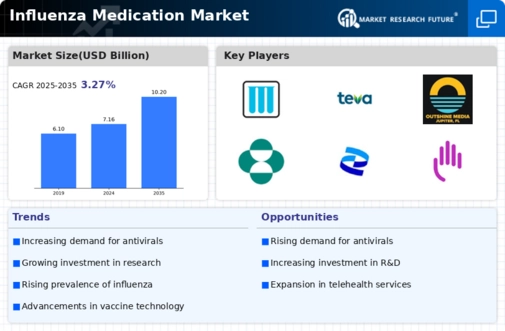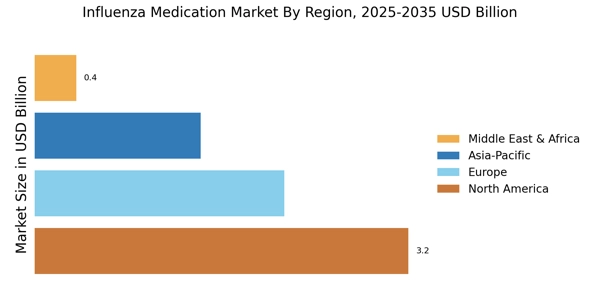Rising Healthcare Expenditure
Rising healthcare expenditure is a pivotal factor driving the Influenza Medication Market. As countries allocate more resources to healthcare, there is an increased focus on infectious disease management, including influenza. This trend is reflected in the growing budgets for antiviral medications and preventive measures. Enhanced healthcare spending facilitates access to innovative treatments and improves patient outcomes. Furthermore, as healthcare systems prioritize the management of infectious diseases, the demand for effective influenza medications is likely to rise. This increase in expenditure not only supports the development of new antiviral therapies but also ensures that existing treatments remain accessible to those in need, thereby bolstering the Influenza Medication Market.
Increasing Incidence of Influenza
The rising incidence of influenza infections is a primary driver for the Influenza Medication Market. Seasonal outbreaks and occasional pandemics contribute to heightened awareness and demand for effective antiviral treatments. According to health authorities, influenza affects millions annually, leading to significant morbidity and mortality. This persistent threat encourages healthcare providers and patients to seek antiviral medications, thereby propelling market growth. The need for timely and effective treatment options is underscored by the economic burden associated with influenza, which includes healthcare costs and lost productivity. As such, the Influenza Medication Market is likely to experience sustained demand as public health initiatives focus on managing and mitigating influenza outbreaks.
Advancements in Vaccine Development
Advancements in vaccine development play a crucial role in shaping the Influenza Medication Market. The continuous evolution of influenza viruses necessitates the development of new vaccines, which in turn drives the demand for antiviral medications. Recent innovations, such as mRNA technology, have shown promise in enhancing vaccine efficacy and adaptability. As vaccination campaigns expand, the need for complementary antiviral treatments becomes apparent, particularly for individuals who may not respond adequately to vaccines. This interplay between vaccination and antiviral medication creates a dynamic market environment, where the Influenza Medication Market must adapt to changing epidemiological patterns and vaccine effectiveness.
Growing Awareness of Antiviral Treatments
Growing awareness of antiviral treatments significantly influences the Influenza Medication Market. Public health campaigns and educational initiatives have increased understanding of the importance of early intervention in influenza cases. As patients become more informed about the benefits of antiviral medications, there is a corresponding rise in demand for these treatments. This trend is particularly evident in high-risk populations, such as the elderly and those with underlying health conditions, who are more susceptible to severe influenza complications. The increased focus on patient education and proactive healthcare measures is likely to enhance the visibility and uptake of antiviral medications, thereby driving growth in the Influenza Medication Market.
Regulatory Support for Antiviral Research
Regulatory support for antiviral research is a significant driver of the Influenza Medication Market. Governments and health organizations are increasingly recognizing the need for effective antiviral therapies to combat influenza. This recognition has led to streamlined approval processes and funding for research and development initiatives. Such support not only accelerates the introduction of new antiviral medications but also encourages pharmaceutical companies to invest in innovative solutions. The favorable regulatory environment fosters collaboration between public and private sectors, enhancing the overall landscape of antiviral research. Consequently, the Influenza Medication Market is poised for growth as new therapies emerge to address the evolving challenges posed by influenza viruses.


















Leave a Comment